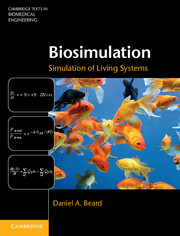Book contents
- Frontmatter
- Contents
- Preface
- Extracts
- 1 Introduction to simulation of biological systems
- 2 Transport and reaction of solutes in biological systems
- 3 Physiologically based pharmacokinetic modeling
- 4 Cardiovascular systems simulation
- 5 Chemical reaction systems: thermodynamics and chemical equilibrium
- 6 Chemical reaction systems: kinetics
- 7 Chemical reaction systems: large-scale systems simulation
- 8 Cellular electrophysiology
- 9 Appendices: mathematical and computational techniques
- References
- Index
1 - Introduction to simulation of biological systems
Published online by Cambridge University Press: 05 June 2012
- Frontmatter
- Contents
- Preface
- Extracts
- 1 Introduction to simulation of biological systems
- 2 Transport and reaction of solutes in biological systems
- 3 Physiologically based pharmacokinetic modeling
- 4 Cardiovascular systems simulation
- 5 Chemical reaction systems: thermodynamics and chemical equilibrium
- 6 Chemical reaction systems: kinetics
- 7 Chemical reaction systems: large-scale systems simulation
- 8 Cellular electrophysiology
- 9 Appendices: mathematical and computational techniques
- References
- Index
Summary
Overview
This chapter is built around analyzing a real data set obtained from a real biological system to illustrate several complementary approaches to simulation and analysis. The particular system studied (a home aquarium) is a well-mixed chemical reactor. Or, more accurately, the system studied is treated as a well-mixed chemical reactor, a basic modeling paradigm that will appear again and again in this book.
Here, we look at this single physical system from several different perspectives (that is, under different sets of underlying modeling assumptions) with the aim of motivating the reader to undertake the study of the rest of this book. The aim is not to overwhelm the reader with mathematical details that can be found in later chapters. Therefore let us clearly state at the outset: it is not expected or required that the reader follow every detail of the examples illustrated here. Instead, we invite the reader to focus on the basic assumptions underlying the methods applied, and to compare and contrast the results that are obtained based on these different approaches. Proceeding this way, it is hoped that the reader may gain an appreciation of the breath of the field. Furthermore, it is hoped that this appreciation will continue to grow with a study of the rest of this book and beyond.
Modeling approaches
The number of different approaches to simulating biosystems behavior is perhaps greater than the number of biological systems.
- Type
- Chapter
- Information
- BiosimulationSimulation of Living Systems, pp. 1 - 20Publisher: Cambridge University PressPrint publication year: 2012

